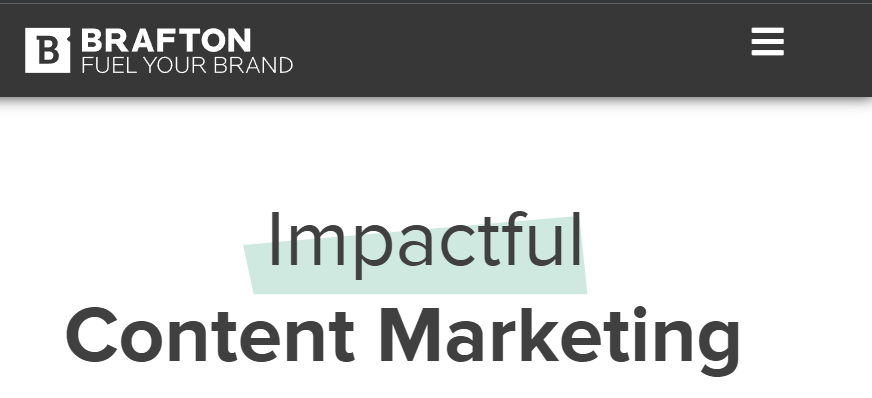High-quality web design is a vital part of the digital marketer’s toolbox. Once visitors have arrived on your company website, it’s up to you to ensure they can easily find everything they’re looking for.
Menus are a key piece of site navigation, and you can’t afford to ignore them when tuning up your site design. The process begins with a question: Will your site have a top menu, an off-canvas menu or both?
A top menu is always present on your site layout, while an off-canvas menu, as the name implies, is waiting off to the side for users to activate it. Each kind of menu has its uses — and a set of design best practices that will help you make the most of it. Putting in the time to study these menus can help you transform your site for the better.
What Are Top Menus and Off-Canvas Menus?
Before you get started optimizing your website menu design, you should know what the terms top menu and off-canvas menu mean. With these definitions in mind, you can shape your site’s user experience and make sure visitors are getting the most out of their time on the webpage.
Top Menu
The top menu or horizontal navigation bar is the list of options across the top of your website. This is a very straightforward and standard piece of web architecture, and has been for decades.

All the options on the top menu are laid out clearly, with each option potentially opening up a drop-down menu containing more links. This type of menu design has the advantage of clarity. Users will immediately know where to look for various options.
As for disadvantages, the top menu’s size can work against it. After all, not every screen is wide today. In the U.S., 91% of people aged 12 and up own a smartphone. This means they could be browsing your website on a small mobile screen in a portrait orientation. A standard top menu may not be as clearly visible or useful.
Off-Canvas Menu
An off-canvas menu is a menu that is hidden by default but appears in the frame when the user clicks a button. The symbol to activate such a menu is often the three horizontal lines colloquially known as a hamburger icon.

The off-canvas menu, like a horizontal navigation bar, can include buttons that expand out to show full categories’ worth of destinations when clicked or hovered over. It allows a wide range of navigation options, potentially taking the place of a navigation bar, but it stays out of the way when collapsed.
On a desktop monitor, an off-canvas menu may feel superfluous, or might not be as clearly, immediately useful as a top menu. In today’s mobile-driven era, however, it’s important to remember that desktop and laptop experiences aren’t the only ones that matter.
Subscribe to
The Content Marketer
Get weekly insights, advice and opinions about all things digital marketing.
Thank you for subscribing to The Content Marketer!
How Do You Design Effective Menus?
It’s impossible to overstate the importance of effective menu design. People visit websites for very specific reasons, whether that’s to gather more information about your company, read an article, watch a video or make an e-commerce purchase. The site menu is the part of the page that gets them where they’re going, so it has to be simple and functional.
What happens when web visitors are confused? Often, they simply leave. A Storyblok survey revealed 60% of people will walk away from an e-commerce purchase in progress if the user experience of the site isn’t working for them.
So, what does it take to create menus that will deliver simple, self-explanatory paths through your site? As it happens, choosing to use an off-panel menu is a great first step. An off-panel menu sliding into action lets users hold their place on the page while also interacting with the menu options — this design helps them multitask.
An off-canvas menu is also a great way to give more options than can comfortably fit in a traditional top menu. Since an off-canvas menu can be as tall as the page itself, it can contain a long list of possible navigation destinations, all without overwhelming the user or making them scroll around the site. This freedom — to explore the page in a user’s own chosen order — is a positive for the overall site experience.
How Does Menu Design Affect Website User Experience?
Some websites are intuitive and pleasant to use, but many aren’t. Customers tend to reject the latter category, and they do it fast. Per the Storyblok survey, 42% of users choose whether they’ll stay on a site within the first 10 seconds. Some don’t even need that long: 20% of users make their choice in 5 seconds.
Since the menu is a user’s gateway to the rest of your website, your design decisions with these interactive elements will play a major role in determining what reaction your page receives. If people can’t easily use the menu to get where they’re going, or they can’t tell where it is or what it does, they’re not likely to stick around.
The NN Group listed some useful tips to keep in mind when creating a menu. For example, you should make sure the top menu — or the button to activate the off-canvas menu — is in a familiar location, right at the top of the page, on the left side or in the right corner. People shouldn’t have to hunt around. Furthermore, the menu should look like a menu. If your buttons are too flashy, visitors may assume they’re not actually interactive.
A highly functional site isn’t necessarily fancy or boundary-pushing. Trying to wow your users with menu design may just end up confusing or inconveniencing them. While an ugly or amateurish site may push customers away, an overly complex one may have the same effect. Perfect web design is focused on being functional and meeting audience needs. If you can achieve those goals, you’re on the right track.
Curious to learn more? See some examples of well-designed webpages that get results.
Mobile vs. Desktop Site Design: What Do You Need To Know?
The difference between desktop and mobile website design is very simple, but also fundamental. It’s all about space. Opening a menu category drop-down on a desktop website doesn’t take up the whole page. Completing the same action on a mobile device can cover the screen — because making clickable options too small would likely be more frustrating for the user, not less.
In short, design decisions are more straightforward for the desktop. When creating mobile-focused sites or the mobile view versions of reactive websites, there are a few important choices to make. This process typically starts with creating an off-canvas menu. From there, you can optimize the way that menu functions to make sure it’s as convenient and intuitive as possible.
Seemingly small differences in the way your off-canvas menu looks can have an outsized effect on how easy it is to use. Smashing Magazine recommended practices such as minimizing icon density alongside the hamburger icon that activates your menu, as well as organizing the order of each menu item by how frequently people will click on it. Using visual cues such as color to indicate what level of a menu people are presently on can also add some clarity.
The organization and style of menus are just a few of the pieces that make up overall website design, but they’re worth an investment of time and effort. Sensible site navigation is a prime way to keep users engaged until they conclude their business with your company.
How does your website design compare to the industry’s best practices? Follow our checklist.
How Do Your Site’s Menus Stack Up?
Websites have to compete on many different levels. To get your customers’ attention and keep it, you should offer a site with strong search engine optimization and rich content, smooth technical performance and pleasing graphic design. All the elements that make up a compelling user experience must be accounted for.
Juggling all the many factors can seem intimidating at first, and this might lead to considerations like menu design falling by the wayside. There’s no need to worry, however. The first step to refreshing your site or building something new entirely is to take a step back and assess its current level of performance.
Is your site easy to navigate? Does it look good? Is the information current? Are there clear ways for users to reach your brand’s preferred outcomes, such as signing up for a newsletter or making a purchase? When was the last time you audited its technical performance or assessed pages’ SEO content strength?
Taking a critical look at your website’s layout and its architecture — including its top menus and off-canvas menus — can remind you what’s working and what needs improvement. Whether you spearhead this process internally or in partnership with experts, it’s a valuable part of creating a competitive and compelling web presence.





